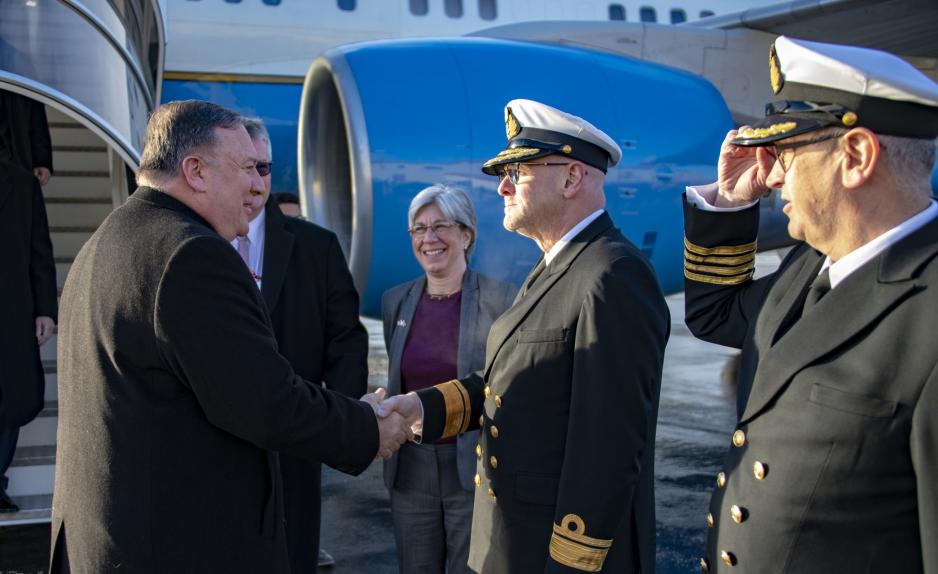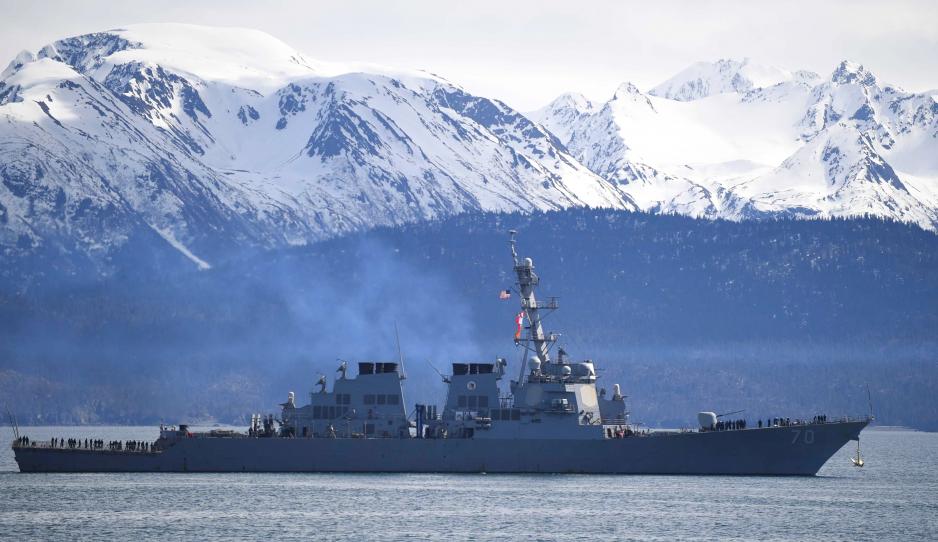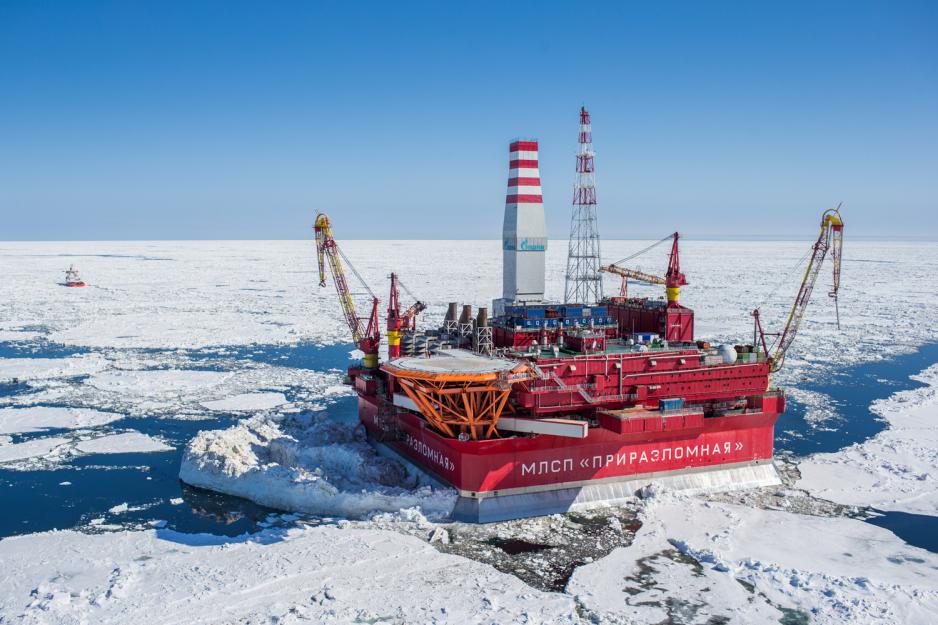The Arctic From An American Military Perspective The Americans are aware that the Russians have had a head start in the Arctic and that China is a joker. That may mean increased military American activity.

US Secretary of State Michael Pompeo arrives at Keflavik Air Base in Reykjavik, Iceland on February 15, 2019. (Source: Courtesy US Department of State)
ANALYSIS: Russia and China are the two nations that have possibly seen the highest potential in this, however, we may expect increased American focus in the time ahead.
In the American National Defense Strategy from 2018, the main focus is a long-term strategic power struggle with China and Russia. Americans do not like that their big power status is challenged, however, that is exactly what has happened in the Arctic. Russia has established herself as the strongest and leanest Arctic nation, whereas the USA has focused on the Middle East and the Pacific region. Russia has invested heavily in the area and plans to invest another USD 700 billion over the next five years. Russia will continue developing infrastructure for the increase in shipping traffic that is expected following the increasing sea ice melting.
China demonstrates significant interest in such a development and a potential future Arctic silk road. China published its first Arctic strategy in 2018; a warning that China wants to be an actor. The country opened its first Arctic research station in Svalbard in 2003 and received observer status at the Arctic Council in 2013. There every reason to believe that China is serious.
The Arctic - from various countries' view
Several countries are currently renewing their Arctic strategies. What significance does that have to Norwegian sovereignty and security?
UTSYN - Forum for Foreign Policy and Security is producing a series of articles on this topic this spring.
The project is a collaboration between UTSYN, the Norwegian Officers' and Specialist Association and NTL Defense.
The Arctic has gone from being a remote no-man’s land to becoming a center for economic activity and a transit area between different strategic interests. The Arctic ties Russia’s oil and gas industry to the Asian markets, Chinese products to European markets anda the Russian Northern Fleet to the Atlantic Ocean. When the polar ice cap shrinks, new and faster transport routes open up; new, rich oil and gas deposits are frequently discovered; and tourism in the area increases. This provides both opportunities and challenges. Russia and China are perhaps the two nations that have seen the most potential here, though we can expect increased American focus in the time ahead.
A recent report to Congress asked if the USA is prepared to defend its interests in the region. The country is far from where it wants to be from a military point of view. The same report estimates that only in 2030 will the US Navy have the competence required, and after 2030 operational equipment, to conduct major operations in the area. Now they want to do something about just that. In 2017, the American Ministry of Defense used NOK 50 billion (USD 5.8 billion) – equaling one year’s Norwegian defense budget – to improve its capacities in the Arctic.
The USA has also reestablished its Second Fleet, having the Atlantic and the Arctic as its area of responsibility. This Navy force was relieved from duty in 2011, however, it is now on its way back and is to be operative by 2020. An American weakness is her lack of icebreakers. The Americans currently have three old and rather worn icebreakers and can hardly claim to have that capacity. However, there are plans of acquiring six icebreakers over the coming years. Only one of them has received funding so far.

Basene på Kolahalvøya erdet eneste utgangspunktet for en sikker sjørute ut i åpent polhav. Derfra kan ubåtene gjemme seg for US Navy, og utgjøre en troverdig motmakt mot USAs militære styrker i en eventuell krise (Foto: US Navy)
Based on this status and the ambitions of the National Security and Defense Strategy, one can safely deduct that the USA has no plans about allowing Russia and China to dominate the Arctic. By 1 June next year, the American Defense Minister will submit an updated Arctic strategy. The previous one was from 2016 and basically held a continue-like-before approach. However, with an ‘America first’ policy there is little doubt that American interests will be promoted in the Arctic too, amongst others to prevent Russia and China from threatening the USA.
The USA has already both introduced and planned initiatives for more active assertion in the Arctic. The US Navy is planning on sending navy forces to the Arctic this summer in order to conduct freedom of navigation operations. This kind of operations is about demonstrating in practice the right Americans claim to have to navigate the sea in a given area based on the international Law of the Seas. The Americans have not done this for a long time in the Arctic, though recently had several such operations in the South China Sea. In addition, the Americans are considering reestablishing a new base in the Bering Sea to support future operations. This base is to be able to receive both surface vessels and maritime surveillance planes. In addition to challenging Russia and China, this is also considered a necessity to acquire knowledge about and experience with operations in the area.
The USA today has unresolved Law of the Seas disputes with both Canada and Russia in the Arctic. The conflicts are a.o. about the strategically important passages that Canada and Russia claim lie within their respective territorial waters or internal sea areas. The USA disagrees with Canada and claims that this is international waters. The USA and Russia disagree about the borders of the Bering Sea. This can nevertheless be considered insignificant details in comparison to what is coming.

Terje Bruøygard, former head of the Telemark Batallion.
Open sea routes are one of the cornerstones of American foreign policy. The outcome of this conflict of interest is not given.
Based on its investment in the Arctic, Russia is planning to submit sovereignty claims along the entire North-East Passage from the Barents Sea to the Bering Strait, in the summer of 2019, amongst which will be a clause requiring foreign marine forces to apply 45 days in advance for access. Russia makes it very clear that she does not want the USA or NATO to flex their muscles along the Russian coastline.
This regulation strongly contrasts the American focus on open sea routes as a precondition for maritime security and global economic growth. The Russian claim is thus a rather exciting preamble for the American freedom of navigation operations. Open sea routes are one of the cornerstones of American foreign policy. The outcome of this conflict of interest is not given.
Activities in the Arctic will increase dramatically over the next years and the area may end up becoming an rena of power wrestling between the USA, Russia and China. Thucydides’ thesis about fear, honor and interest as causes of conflicts reminds us of the insecurity that may arise between an established superpower and a growing challenger. In such power struggles, where most of those involved have some form of alliance and the conflict lines are forking, a spark may lead to flashover. It will be incredible exciting to watch the announced activities with American freedom of navigation operations, Russian assertion and aggressive Chinese entering of the region. Even the Canadians are rattling their sabers and preparing reactions – not militarily, of course, but diplomatically. There is no reason to believe that the USA will sit still and watch Russia and China grow stronger in the Arctic. Nor is there reason to believe that Russia will give up her position or that China will give up its ambition.
A culmination of territorial claims and interpretations of international legislation in the Arctic may also challenge Norway. We may end up in a squeeze between a Russia that has already significantly strengthened her position in the Arctic and a USA that has an ambition of claiming its rightful place in the region. No one doubts that Svalbard is a part of Norway, however, the archipelago’s unique legal framework constitutes a potential disagreement in which Norway may be left dangerously alone. Norway’s claim for an exclusive economic zone around Svalbard is challenged not only by Russia, but even more by NATO allies such as Iceland, Denmark, Spain and Great Britain. The USA has assumed a more cautious position. China is a signature state to the Svalbard Treaty and has recently claimed its interest in the archipelago to be a.o. research, mining and tourism. It may be exciting to see how that ambition is played out over the coming years.

The high costs of developing the required infrastructure is also reflected in Russia’s announcement earlier this week to welcome Chinese firms to take part in Russia’s offshore Arctic projects. (Illustration image: Wikipedia/Krichevsky)
So, what does a reinforced American military strategy for the Arctic, aimed towards containing Russian and Chinese positioning, have to say for Norway and our defense? Well, these are first and foremost diplomatic challenges that should be met with peaceful means and international cooperation. At the same time, diplomacy has to be supported by the state’s other tools, including the military. On the shorter term, we may prioritize the structures we have, so that our position in strategic questions in the Arctic is more credible. Sailing hours, flying hours and drill activity is not only a means to achieve a better operative status; they are also a signal that we are serious. If we have a continual presence in our areas, be it in the air, on sea or on land, this goes to say something. If our vessels are berthed, or planes in their hangars and our army in its barracks, this sends a different message. What we exercise, who we train with and where we train goes a long way in saying how Norway as a state intends to protect its interests. The Defense activity thus gives a signal to both allies as well as other actors in the region.
The long-term development communicates even stronger what our interest is. The fact that Norway buys new F-35s and new maritime surveillance planes communicates that we are a strong partner to the USA and that we are willing to defend our interests. As for submarines, it appears we are reducing our fleet from six to four and we are reducing the number of frigates from five to four. Perhaps it would be wise to consider increasing both the number of submarines, replacing the shipwrecked frigate and acquiring a further number of vessels designed especially for operating in the Arctic.
Perhaps it would be wise to consider increasing both the number of submarines, replacing the shipwrecked frigate and acquiring a further number of vessels designed especially for operating in the Arctic.
Norwegian land power also has a border area to American strategy. Joint training and cooperation with a competent Arctic nation like Norway is highly valued also for land forces. Maintaining and protecting American advance storages is important, in particular for the marine corps. An American amphibian brigade group depends on a land component level above today’s brigade level. Furthermore, the geostrategic significance of Norway is crucial for the USA, both for defending the American mainland as well as for its ability to operate in the Atlantic Ocean. A potential enemy controlling Norwegian territory would be very unpleasant for the USA. Therefore, no one should raise their eyebrows when the Chief of the Army says that we need another brigade. Adding a brigade would close some of the capacity gap on the Norwegian territory through being able to protect more of the land-based infrastructure and provide more flexibility, robustness and endurance.
There is no doubt that it will be exciting to see what will be the direction of a new American Arctic strategy. The USA has ambitions to remain a global superpower. The Americans are aware that the Russians have had a head start in the Arctic and that China is a joker. That may mean increased military American activity, more investments, closer cooperation and sharpened policies. Norway must, as an Arctic actor, balance three different interests. We must continue to demonstrate our loyalty to the Americans and NATO, we must work for a good neighborly relation to Russia, and we must assert our rights in the Arctic in a credible manner.
There is no doubt that it will be exciting to see what will be the direction of a new American Arctic strategy.
This analysis originally appeared in Norwegian and has been translated by HNN's Elisabeth Bergquist.
